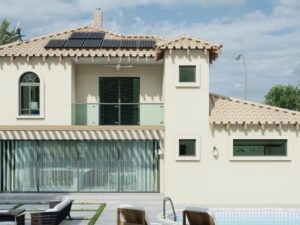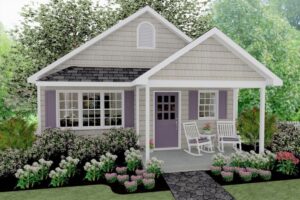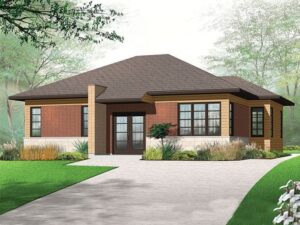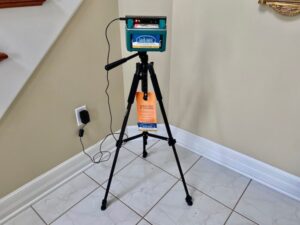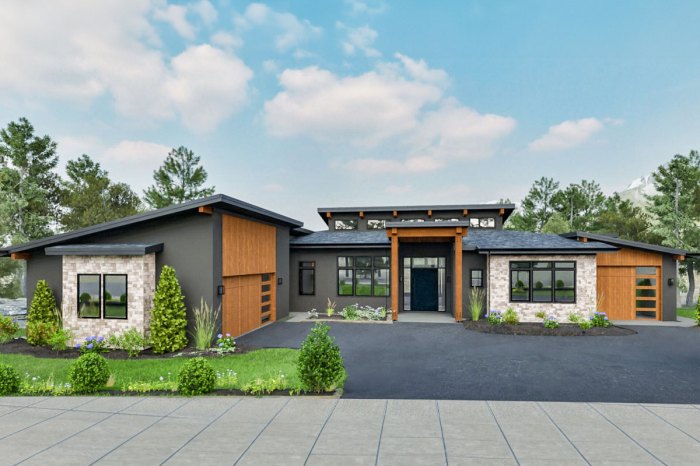
Multi-generational home layouts are becoming increasingly popular as families seek living arrangements that foster connection while providing individual privacy. This concept embraces the idea of multiple generations cohabitating under one roof, allowing for shared resources and support. With the rising costs of living and the desire for close family ties, designing homes that cater to diverse age groups has never been more relevant.
In this discussion, we will explore various aspects of multi-generational living, including architectural styles that accommodate different needs, the essential features of functional spaces, and how to incorporate sustainable practices for a better living experience. Whether you’re considering building a new home or modifying an existing one, understanding these layouts can significantly enhance family life.
Understanding Multi-generational Home Layouts
Multi-generational living is becoming an increasingly popular housing solution, reflecting the evolving dynamics of family structures. This arrangement involves multiple generations of a family residing together under one roof, which can foster closer relationships and provide support for various life stages. The benefits of this living arrangement are significant, including cost savings, shared responsibilities, and enhanced emotional connections.When it comes to multi-generational home layouts, there are several distinct styles designed to cater to the needs of all family members, from young children to elderly relatives.
These layouts are thoughtfully planned to provide privacy while facilitating interaction. The options range from separate entrances and living spaces to fully integrated designs that promote community living within the home.
Types of Multi-generational Home Layouts
Each multi-generational home layout serves a specific purpose, addressing the different needs of family members. Below are some of the most common types of layouts:
- Duplex Designs: These homes consist of two separate living units within a single structure, often with separate entrances. This arrangement provides independence while keeping family close.
- In-Law Suites: Featuring a private bedroom, bathroom, and sometimes a kitchenette, in-law suites are designed for elderly family members or young adults looking for autonomy while still being part of the household.
- Split-Level Homes: This design includes multiple levels within a single home, allowing for separate living spaces. It creates a unique environment where family members can enjoy both privacy and communal areas.
- Single-Family Homes with Adaptations: Many traditional homes can be modified to include accessibility features or additional rooms, accommodating the varying needs of family members.
Popular Architectural Styles for Multi-generational Homes
Several architectural styles lend themselves particularly well to multi-generational living, each offering unique features that enhance the experience. Here are some noteworthy examples:
- Craftsman Style: Known for its wide porches and open floor plans, Craftsman homes often include flexible spaces that can be adapted for different family needs. The use of natural materials creates a warm and inviting atmosphere.
- Colonial Style: Traditional colonial homes often feature distinct rooms that can be designated for different generations. Their classic design can be easily expanded or modified to include private suites.
- Modern Farmhouse: This style combines rustic charm with modern conveniences. Its open layout fosters family interaction while allowing for dedicated private areas, making it an excellent choice for multi-generational living.
- Ranch Style: Single-story ranch homes provide easy accessibility for older family members. The open layout allows for seamless transitions between shared spaces and private bedrooms.
“Multi-generational homes are not just about space; they are about building a legacy and nurturing family bonds.”
Designing Functional Spaces
Creating functional spaces in multi-generational homes involves a delicate balance of privacy, communal interaction, and accessibility. This design approach not only accommodates diverse family structures but also fosters a harmonious living environment for everyone involved. By integrating essential features, families can thrive together while respecting their individual needs and preferences.
Enhancing Privacy in Multi-Generational Homes
Maintaining privacy is crucial in multi-generational homes where multiple family units coexist. By implementing specific design features, homeowners can create personal areas that allow each generation to have their own space while still enjoying the benefits of communal living. Key features that enhance privacy include:
- Separate Entrances: Providing distinct entrances for different family units can help to maintain independence and personal space.
- Private Bedrooms with En-Suite Bathrooms: Designing bedrooms with attached bathrooms ensures privacy and convenience for family members.
- Soundproofing: Utilizing soundproof materials in walls and floors can minimize noise, making it easier for family members to enjoy their personal time without disturbances.
- Strategic Layout: Arranging the layout in such a way that private areas are separated from communal spaces can enhance the feeling of privacy.
Creating Communal Spaces that Encourage Family Interaction
Communal spaces play a significant role in fostering family interaction and bonding within a multi-generational home. Thoughtfully designed areas promote togetherness and shared experiences. The importance of these communal spaces can be summarized as follows:
- Open Floor Plans: Open-concept living areas allow for easy movement and interaction, encouraging family members to engage with one another.
- Gathering Areas: Designating spaces such as a large dining room or cozy living room creates opportunities for family gatherings, which can strengthen relationships.
- Outdoor Spaces: Incorporating patios or gardens that can accommodate family gatherings promotes outdoor interaction and leisure activities.
- Common Kitchens: A spacious kitchen serves as a central hub for cooking and family meals, fostering collaboration and shared culinary experiences.
Importance of Accessibility in Multi-Generational Home Designs
Accessibility is a critical factor in the design of multi-generational homes, particularly for families that include elderly or differently-abled members. Ensuring that all areas of the home are easily navigable can significantly improve the quality of life for everyone. Key considerations for accessibility include:
- Single-Story Layouts: Designing homes primarily on one level can eliminate stairs, making it easier for all family members to move around safely.
- Wider Doorways and Hallways: Ensuring that doorways and hallways are wide enough to accommodate wheelchairs or walkers is essential for mobility.
- Accessible Bathrooms: Installing grab bars, curbless showers, and non-slip flooring in bathrooms ensures safety and ease of use for individuals with limited mobility.
- Smart Home Technology: Incorporating technology that can assist with daily tasks, such as voice-activated controls and automated lighting, can enhance accessibility for all family members.
Designing functional spaces in multi-generational homes enhances privacy, promotes interaction, and ensures accessibility, creating a balanced and harmonious living environment.
Home Furniture Considerations

Selecting furniture for a multi-generational home is a thoughtful process that requires consideration of the diverse needs and preferences of all family members. From the youngest to the oldest, each age group has specific requirements that must be addressed through design and functionality. The right furniture not only enhances comfort but also facilitates interaction and accessibility within shared spaces, ultimately creating a harmonious living environment.
Furniture Styles that Suit Multi-Generational Homes
When it comes to choosing furniture styles for a multi-generational home, versatility and cohesiveness are key. Popular styles that work well include contemporary, transitional, and traditional designs, which can blend seamlessly with different tastes while providing functionality. Here are some important factors to consider:
- Durability: Opting for materials that withstand wear and tear is essential. Furniture made from hardwood or quality upholstery can endure the rigors of daily family life.
- Comfort: Look for pieces that offer ample cushioning and support, especially for older adults and children. Sofas with firm cushions and armrests can provide stability.
- Modular Designs: Modular furniture pieces, like sectionals or interchangeable shelving units, can adapt to changing needs and room layouts, making them ideal for dynamic family living.
Selecting Furniture that Accommodates Varying Age Groups
Choosing furniture that meets the needs of varying age groups requires a careful balance of style, comfort, and practicality. The following tips can help ensure that your selections cater to everyone in the household:
- Height Considerations: Furniture should be at a height that’s accessible for all ages. For example, coffee tables should be low enough for children and seniors to reach easily.
- Multi-functional Pieces: Select furniture that serves more than one purpose, such as ottomans that double as storage or dining tables that can expand for larger gatherings.
- Easy Mobility: Choose lightweight furniture or pieces with wheels to allow for easy rearranging by all family members, promoting interaction and customization of space.
Adaptable Furniture Solutions for Shared Spaces
Shared spaces in a multi-generational home benefit greatly from adaptable furniture solutions that cater to various activities and preferences. Here are some examples of how to achieve this:
- Convertible Sofas: Sofas that can transform into beds provide extra sleeping space for guests or family members, making them perfect for multi-functional living areas.
- Adjustable Dining Tables: Tables that can expand or contract allow for flexibility in dining experiences, accommodating both everyday meals and larger family gatherings.
- Accessible Storage Solutions: Open shelving and low drawers make it easier for everyone, including children and seniors, to access items without assistance.
“Furniture in a multi-generational home should promote both comfort and functionality to enhance the living experience for all family members.”
Incorporating Green Living Principles
Designing a multi-generational home with sustainable practices not only benefits the environment but also enhances the quality of life for all residents. The integration of eco-friendly materials and energy-efficient features can create a comfortable living space that accommodates diverse needs while promoting a healthier lifestyle. Embracing green living principles helps families reduce their carbon footprints and fosters a sense of community responsibility among generations.
Eco-Friendly Materials for Construction
When designing a multi-generational home, selecting eco-friendly materials is crucial. These materials minimize environmental impact and can improve indoor air quality and energy efficiency. Consider the following types of materials:
- Recycled Materials: Utilizing recycled concrete, wood, or metals can significantly reduce waste and resource consumption.
- Sustainable Wood: Sourcing certified timber, such as FSC (Forest Stewardship Council) approved wood, ensures responsible forestry practices.
- Low-VOC Paints: Choosing paints with low volatile organic compounds (VOCs) contributes to a healthier indoor environment.
- Natural Insulation: Materials like sheep’s wool, cellulose, or hemp provide excellent insulation while being environmentally friendly.
Incorporating these materials not only benefits the planet but also promotes the well-being of the inhabitants by reducing exposure to harmful substances.
Sustainable Practices in Daily Living
Integrating sustainable practices into daily routines is essential for maximizing the benefits of a green home. Families can foster a culture of sustainability through various methods:
- Composting: Setting up a composting system encourages waste reduction and provides nutrient-rich soil for gardening.
- Water Conservation: Installing low-flow faucets, showerheads, and rainwater harvesting systems can significantly reduce water usage.
- Gardening: Creating vegetable and herb gardens promotes self-sufficiency and encourages healthy eating habits.
- Energy-Efficient Appliances: Utilizing ENERGY STAR-rated appliances can lead to significant energy savings and lower utility bills.
These practices not only enhance sustainability but also serve as educational tools for younger generations, fostering a deeper understanding of environmental stewardship.
Energy-Efficient Features for All Generations
Implementing energy-efficient features makes a multi-generational home more comfortable and cost-effective. Key elements to consider include:
- Solar Panels: Installing solar panels generates renewable energy and can dramatically reduce electricity costs.
- Smart Thermostats: These devices enable residents to optimize heating and cooling, enhancing comfort and reducing energy waste.
- High-Efficiency Windows: Double or triple-glazed windows provide better insulation, reducing heating and cooling demands.
- LED Lighting: Switching to LED bulbs not only lowers energy consumption but also has a longer lifespan compared to traditional bulbs.
Adopting these energy-efficient features not only lowers household expenses but also creates a more sustainable environment for all generations living together.
Heating and Air Conditioning Solutions
In a multi-generational home, maintaining a comfortable living environment is essential for everyone, from the youngest members to the elders. Proper heating and air conditioning play a pivotal role in ensuring that all generations feel at ease in their shared spaces. Choosing the right HVAC system and optimizing it for various needs can create a harmonious atmosphere that promotes well-being and comfort.Selecting an effective HVAC system tailored for a multi-generational home is crucial.
Options such as central heating and cooling systems, ductless mini-split systems, or heat pumps can be considered based on the size of the home and the specific needs of its occupants. Each system has its benefits and can significantly affect energy efficiency, comfort levels, and overall satisfaction.
HVAC System Types
The choice of HVAC system can impact both comfort and energy consumption in a multi-generational household. Here are some popular options:
- Central Air Conditioning and Heating: Ideal for larger homes, central systems provide uniform heating and cooling throughout, ensuring every room is comfortable.
- Ductless Mini-Split Systems: These offer flexible installation and zoning capabilities, perfect for homes where different generations may have varying temperature preferences.
- Heat Pumps: Efficient for both heating and cooling, heat pumps can be a cost-effective solution in moderate climates.
Zoning systems add a layer of efficiency and customization to HVAC solutions. By creating separate zones within the house, families can optimize heating and cooling based on individual preferences and usage patterns. This approach not only enhances comfort but also leads to energy savings.
Zoning Systems
Implementing zoning in a multi-generational home can significantly enhance comfort and efficiency. Here are some considerations for effective zoning:
- Thermostat Control: Using multiple thermostats allows occupants to control the temperature in different areas, catering to the unique needs of various generations.
- Smart HVAC Technologies: Smart systems can be programmed to adjust based on occupancy, time of day, or specific preferences, offering convenience and efficiency.
- Proper Insulation: Ensuring that different zones are well-insulated aids in maintaining desired temperatures without overworking the HVAC system.
Indoor air quality is another critical aspect, especially in homes with shared spaces where multiple generations interact. It directly impacts health, comfort, and overall quality of life.
Indoor Air Quality Improvement
Effective indoor air quality management in a multi-generational home involves several strategies. Here are ways to enhance the air quality in shared spaces:
- Regular Maintenance: Routine maintenance of HVAC systems, including filters and duct cleaning, ensures that the air circulating is free from dust and allergens.
- Air Purifiers: Investing in high-efficiency particulate air (HEPA) filters or air purifiers can significantly reduce pollutants, making the air healthier for everyone.
- Proper Ventilation: Ensuring adequate ventilation helps to bring in fresh air, reducing stale air build-up and improving overall air quality.
In summary, selecting the right HVAC system, utilizing zoning for personalized comfort, and prioritizing indoor air quality all contribute to a nurturing environment for all generations living under one roof.
Importance of Home Inspections
Home inspections are a critical step in the process of purchasing or renovating a multi-generational home. These inspections help identify potential issues that could affect the safety and functionality of the living space, especially when accommodating a range of ages and abilities. A thorough home inspection ensures that all family members can enjoy a comfortable and secure environment.A home inspection for multi-generational properties focuses on various aspects that might be overlooked in traditional inspections.
Key areas include safety features, accessibility modifications, and structural integrity. Inspectors will also evaluate the condition of plumbing, electrical systems, and appliances to ensure they are suitable for diverse needs. It is essential to address these concerns early to prevent future hazards or costly repairs.
Key Aspects of Home Inspection
When assessing a multi-generational home, inspectors pay particular attention to aspects that promote safety and comfort for all ages. Here are some critical evaluation points:
- Safety Features: Inspectors check for smoke detectors, carbon monoxide detectors, and fire extinguishers in accessible locations to ensure the safety of all residents.
- Accessibility: Evaluate door widths, staircases, and bathroom layouts to confirm they are suitable for both elderly family members and young children.
- Structural Integrity: Inspect walls, foundations, and roofs for signs of wear or damage that could impact safety or comfort.
- Systems Functionality: Assess heating, ventilation, and air conditioning systems to ensure they meet the demands of a larger household.
- Environmental Concerns: Look for mold, asbestos, and other hazardous materials that may affect health, especially for sensitive individuals.
Common Issues in Multi-Generational Homes
Multi-generational homes often have unique challenges due to the diverse needs of residents. Understanding these common issues can help in planning effective solutions:
- Space Utilization: Many rooms may not be optimized for shared living, leading to conflicts over personal space and privacy.
- Maintenance Backlog: Older homes may suffer from deferred maintenance, requiring immediate attention to plumbing, roofing, or electric systems.
- Wear and Tear: Higher occupancy rates can lead to faster degradation of appliances, fixtures, and overall home conditions.
- Childproofing and Safety: Ensuring the home is safe for young children, while accommodating the elderly, can be complex and requires thoughtful design modifications.
- Potential for Conflicts: Different lifestyle habits and needs can lead to conflicts among family members, necessitating adequate space and shared areas.
Tips for Ensuring Safety and Functionality
Creating a safe and functional living environment for all ages requires careful planning and proactive measures. Here are some important tips:
- Regular Inspections: Schedule periodic inspections to detect issues early, especially in high-use areas.
- Adaptable Spaces: Design flexible living areas that can be easily modified as the needs of the family change over time.
- Universal Design Principles: Incorporate features like grab bars, non-slip flooring, and wider doorways to ensure accessibility for everyone.
- Communication: Foster open communication among family members regarding shared spaces and responsibilities to minimize conflicts.
- Emergency Preparedness: Establish and practice emergency plans that accommodate all residents, ensuring everyone knows the safest exits and procedures.
Planning Effective House Plans
When designing a multi-generational home, careful planning is crucial to meet the diverse needs of all residents. A well-thought-out house plan not only ensures comfort and functionality but also fosters a sense of togetherness while respecting individual privacy. One of the essential elements to consider in a multi-generational house plan is the incorporation of various living spaces that cater to different family members.
This includes private rooms, shared common areas, and specialized zones for activities. A balanced approach to design allows for both communal interactions and personal retreats.
Essential Elements in Multi-Generational House Plans
Incorporating the right elements into your house plan can significantly enhance the livability of a multi-generational home. The following components are vital:
- Separate Entrances: Having distinct entrances for different family units can provide privacy and independence while still being part of the same household.
- Flexible Living Spaces: Designing open and adaptable living areas that can be altered according to family needs ensures longevity in usage.
- Multi-functional Rooms: Rooms that can serve different purposes, like a guest room that doubles as an office, can maximize space efficiency.
- Adequate Storage: Sufficient storage solutions help reduce clutter and promote organization across various family members’ belongings.
- Accessible Design: Features such as wider doorways and single-level living can accommodate elderly family members or those with mobility issues.
Considerations for Future Expansions or Modifications
It’s important to consider potential changes in family dynamics or needs over time. A house plan should allow for easy adaptations. Key considerations include:
- Expandable Footprint: Leave space in the design for future additions, such as extra bedrooms or a separate suite.
- Utility Planning: Design plumbing and electrical systems with the potential for future upgrades or expansions.
- Structural Flexibility: Use materials and construction techniques that facilitate changes without requiring extensive renovations.
- Outdoor Space: Plan for yards or patios that can accommodate future enhancements like a deck or garden.
Balancing Personal Space with Shared Areas
Creating a harmonious balance between private and shared spaces is essential in a multi-generational home. This balance ensures that all family members feel comfortable and respected. Consider the following strategies:
- Designated Private Areas: Allocate specific rooms for individual family units to retreat to when they need solitude.
- Communal Zones: Create inviting shared spaces, such as a large kitchen or living room, that encourage family gatherings and interactions.
- Soundproofing: Incorporate soundproofing materials between private areas and common spaces to enhance privacy.
- Outdoor Extensions: Utilize outdoor areas like porches or gardens as additional communal spaces that can be enjoyed together.
Ending Remarks

To sum up, multi-generational home layouts provide innovative solutions for families looking to thrive together while maintaining their unique identities. By prioritizing privacy, communal areas, and eco-friendly designs, these homes not only enhance daily living but also promote stronger family bonds. Embracing this trend can lead to a harmonious living experience that benefits every generation.
FAQ Overview
What are the main benefits of multi-generational home layouts?
They foster closer family relationships, reduce living costs, and provide mutual support among family members.
How can privacy be achieved in multi-generational homes?
By designing separate living spaces, using soundproof materials, and implementing strategic layouts that minimize shared areas.
What types of furniture work best in multi-generational homes?
Adaptable and versatile furniture that accommodates different ages and needs, such as modular seating and extendable tables.
How can eco-friendly practices be incorporated in these homes?
Utilizing sustainable materials, energy-efficient appliances, and incorporating green spaces or gardens within the property.
What should be considered in home inspections for multi-generational properties?
Inspecting for safety features, accessibility, and ensuring that all areas are functional and comfortable for various age groups.
